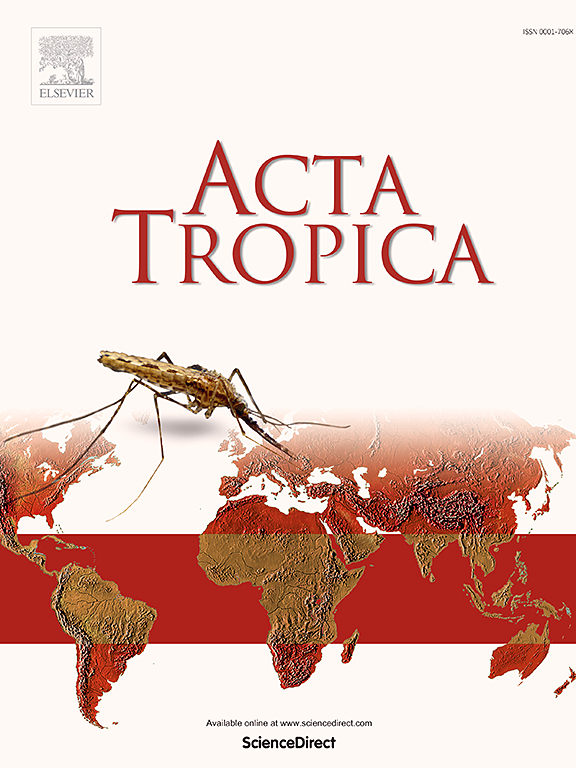Co-circulation of multiple serotypes of foot and mouth disease virus among susceptible multispecies animal population in India during 2021-2022
IF 2.1
3区 医学
Q2 PARASITOLOGY
引用次数: 0
Abstract
India, with over 535 million livestock, is one of the largest and most densely populated countries in Asia in terms of livestock population. Transboundary animal diseases, such as foot and mouth disease (FMD), pose significant constraints on the development of progressive livestock enterprises in developing countries. During 2021–2022, a relatively higher number of suspected FMD outbreaks were reported across multiple species in most states and union territories (UTs). In addition to cattle, other affected species included buffalo, sheep, goat, pig, mithun, and yak. Clinical samples (tongue epithelium, oral mucosa, oral swab, foot or snout epithelium, and saliva) were collected from these species and tested using in-house serotyping ELISA, followed by reverse-transcription multiplex PCR. Multiple FMDV serotypes were detected in different states and UTs. For example, both serotypes O and A were detected in six states: Maharashtra, Uttar Pradesh, Punjab, Odisha, Nagaland, and Karnataka. Serotype O alone was identified in 23 other states/UTs. All three serotypes including O, A, and Asia 1 were detected in Tamil Nadu and Jammu & Kashmir. The detection of multiple FMDV serotypes across different states and animal species indicates the co-circulation of diverse virus strains, which presents a significant challenge for disease control and prevention. Factors contributing to the spread and persistence of the disease include the common practice of mixed farming in India, where multiple species are housed together, and the migratory nature of small ruminant flocks, particularly in regions like Jammu and Kashmir. Additionally, the cyclic pattern of FMD incidence, likely influenced by delayed vaccination and waning immunity from natural infections, further complicates the epidemiological landscape. Given the complexity of the situation and the diversity of circulating FMDV serotypes, implementing a monovalent vaccine program is currently not advisable. Instead, a comprehensive FMD control strategy is essential. This should be informed by detailed epidemiological analysis and surveillance and supported by the use of high-quality vaccines, accompanied by uniformly practiced and timely vaccination efforts, to effectively manage the disease and mitigate its impact.
2021-2022年印度多种易感动物种群中多种血清型口蹄疫病毒的共循环
印度拥有超过5.35亿头牲畜,就牲畜数量而言,是亚洲最大和人口最稠密的国家之一。跨界动物疾病,如口蹄疫,对发展中国家畜牧企业的发展构成重大制约。在2021-2022年期间,在大多数邦和联邦领土(UTs)报告的跨多个物种的疑似口蹄疫暴发数量相对较高。除牛外,其他受影响的物种包括水牛、绵羊、山羊、猪、野牛和牦牛。从这些物种中收集临床样本(舌上皮、口腔黏膜、口腔拭子、足或鼻上皮和唾液),并使用内部血清分型ELISA进行检测,然后进行反转录多重PCR。在不同的州和地区检测到多种FMDV血清型。例如,在马哈拉施特拉邦、北方邦、旁遮普邦、奥里萨邦、那加兰邦和卡纳塔克邦六个邦检测到O型和A型血清。在其他23个州/ ut中仅鉴定出血清O型。在泰米尔纳德邦和查谟和克什米尔地区检测到所有三种血清型,包括O、A和亚洲1型。在不同国家和动物物种中检测到多种口蹄疫血清型,表明多种病毒株存在共循环,这对疾病控制和预防提出了重大挑战。导致该疾病传播和持续存在的因素包括:印度普遍采用混合耕作的做法,将多种动物放在一起饲养;小型反刍动物群的迁徙性质,特别是在查谟和克什米尔等地区。此外,口蹄疫发病率的循环模式可能受到延迟接种疫苗和自然感染免疫力下降的影响,这进一步使流行病学形势复杂化。鉴于情况的复杂性和流行的口蹄疫血清型的多样性,目前不建议实施单价疫苗规划。相反,一项全面的口蹄疫控制战略至关重要。这方面应以详细的流行病学分析和监测为依据,并得到使用高质量疫苗的支持,同时进行统一和及时的疫苗接种工作,以有效管理该疾病并减轻其影响。
本文章由计算机程序翻译,如有差异,请以英文原文为准。
求助全文
约1分钟内获得全文
求助全文
来源期刊

Acta tropica
医学-寄生虫学
CiteScore
5.40
自引率
11.10%
发文量
383
审稿时长
37 days
期刊介绍:
Acta Tropica, is an international journal on infectious diseases that covers public health sciences and biomedical research with particular emphasis on topics relevant to human and animal health in the tropics and the subtropics.
 求助内容:
求助内容: 应助结果提醒方式:
应助结果提醒方式:


